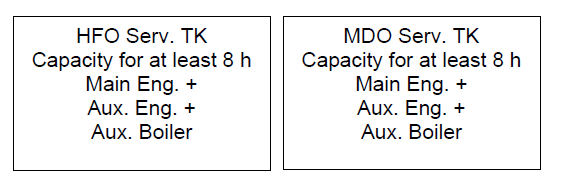4.1 PARAGRAPH 4
Interpretation
1 Dead ship condition for the purpose of regulation II-1/26.4 should be understood to mean a
condition under which the main propulsion plant, boilers and auxiliaries are not in
operation and in restoring the propulsion, no stored energy for starting and
operating the propulsion plant, the main source of electrical power and other
essential auxiliaries is assumed to be available.
2 Where the emergency source of power is an emergency generator which
complies with regulation II-1/44, IACS SC185 and IACS SC124, this
generator may be used for restoring operation of the main propulsion plant, boilers
and auxiliaries where any power supplies necessary for engine operation are also
protected to a similar level as the starting arrangements.
3 Where there is no emergency generator installed or an emergency
generator does not comply with regulation II-1/44, the arrangements for bringing main and
auxiliary machinery into operation should be such that the initial charge of
starting air or initial electrical power and any power supplies for engine operation
can be developed on board ships without external aid. If for this purpose an
emergency air compressor or an electric generator is required, these units should be
powered by a hand-starting oil engine or a hand-operated compressor. The
arrangements for bringing main and auxiliary machinery into operation should have
capacity such that the starting energy and any power supplies for engine operation
are available within 30 min of a dead ship condition.
4.2 PARAGRAPH 11
Interpretation
1 Arrangements complying with this regulation and acceptable "equivalent
arrangements", for the most commonly utilized fuel systems, are shown below.
2 A service tank is a fuel oil tank which contains only fuel of a quality
ready for use, i.e. fuel of a grade and quality that meets the specification
required by the equipment manufacturer. A service tank should be declared as such
and not be used for any other purpose.
3 Use of a setting tank with or without purifiers, or purifiers alone,
and one service tank is not acceptable as an "equivalent arrangement" to two service
tanks.
Examples of application for the most common systems
1 Example 1
1.1 Requirement according to SOLAS – Main and auxiliary engines and boiler(s)
operating with heavy fuel oil (HFO) (one fuel ship)

1.2 Equivalent arrangement

This interpretation only applies where main and auxiliary engines can operate with
heavy fuel oil under all load conditions and, in the case of main engines, during
manoeuvring.
For pilot burners of auxiliary boilers if provided, an additional MDO
tank for 8 hours may be necessary.
2 Example 2
2.1 Requirement according to SOLAS – Main engine(s) and auxiliary boiler(s)
operating with HFO and auxiliary engine operating with marine diesel oil
(MDO)

2.2 Equivalent arrangement

The arrangements in paragraphs 1.2 and 2.2 apply, provided the propulsion and vital
systems which use two types of fuel support rapid fuel changeover and are capable of
operating in all normal operating conditions at sea with both types of fuel (MDO and
HFO).